Introduction to the Ultimate Python Course
Have you ever wanted to learn coding but felt like it’s too complicated? Or maybe you’ve tried a programming language before, but it felt too technical? Well, Python is different. It’s one of the easiest languages to learn, and at the same time, it’s powerful enough to build almost anything—websites, games, AI, data analysis, and more!

Why Should You Learn Python?
Python is everywhere! It’s used by Google, Netflix, NASA, and even Instagram. Here’s why people love it:
- Simple and easy to read – The code looks like plain English. No weird symbols or complicated syntax.
- Super versatile – Whether you want to build a website, analyze data, or make a chatbot, Python has you covered.
- Tons of job opportunities – Python developers are in high demand, and it’s one of the highest-paying programming skills.
- Huge community support – If you ever get stuck, there are millions of Python programmers ready to help.
What Will You Learn in This Course?
This course will take you step by step from a total beginner to an expert. Here’s a sneak peek of what we’ll cover:
- Getting Started – Installing Python and writing your first program.
- Understanding the Basics – Variables, data types, and simple math operations.
- Making Decisions in Code – Using
if-elsestatements to control how your program runs. - Loops & Patterns – Making the computer repeat things without writing extra code.
- Functions – Breaking code into small, reusable pieces.
- Lists, Dictionaries & More – Storing and organizing data efficiently.
- Working with Files – Reading and writing data to text files.
- Error Handling – Fixing mistakes like a pro!
- Object-Oriented Programming (OOP) – Learning how big projects are built.
- Fun Projects – Create a calculator, a guessing game, and even a simple chatbot.
And that’s just the beginning!
Who is This Course For?
- This course is for YOU if you:
- Have never coded before and want to start from scratch.
- Tried programming but got confused and gave up.
- Want to switch careers and enter the tech world.
- Love solving problems and want to build cool projects.
By the End of This Course…
You’ll be able to:
- Write Python programs with confidence.
- Build your own projects from scratch.
- Understand how real-world applications are made.
- Have a strong foundation to learn advanced topics like AI and web development.
Let’s Get Started!
Python is fun, powerful, and in demand. This course will make learning Python easy and enjoyable for you. So, are you ready to start coding? Let’s do this together!
01 – Python Fundamentals
In this section, let’s explore how computers work, why we need programming languages, and the fundamentals of Python. We’ll break down how a computer processes data, why we can’t just talk to it directly, and how Python makes coding simple. We’ll also go over installing Python on your computer and writing your first Python program. By the end, you’ll have everything set up and be ready to start coding!
By the end of this section, you’ll have Python set up and a solid foundation to start coding. Let’s get started!

- Python Implementations: CPython, PyPy, Jython, and IronPython
- How Python Programs Are Executed
- Python Terminology Cheat Sheet for Interviews
- Installing Python and Running First Program
- Comments in Python
- Documentation in Python – Part 1
- Documentation in Python – Part 2
02 – Variables, Data Types, and Memory Management
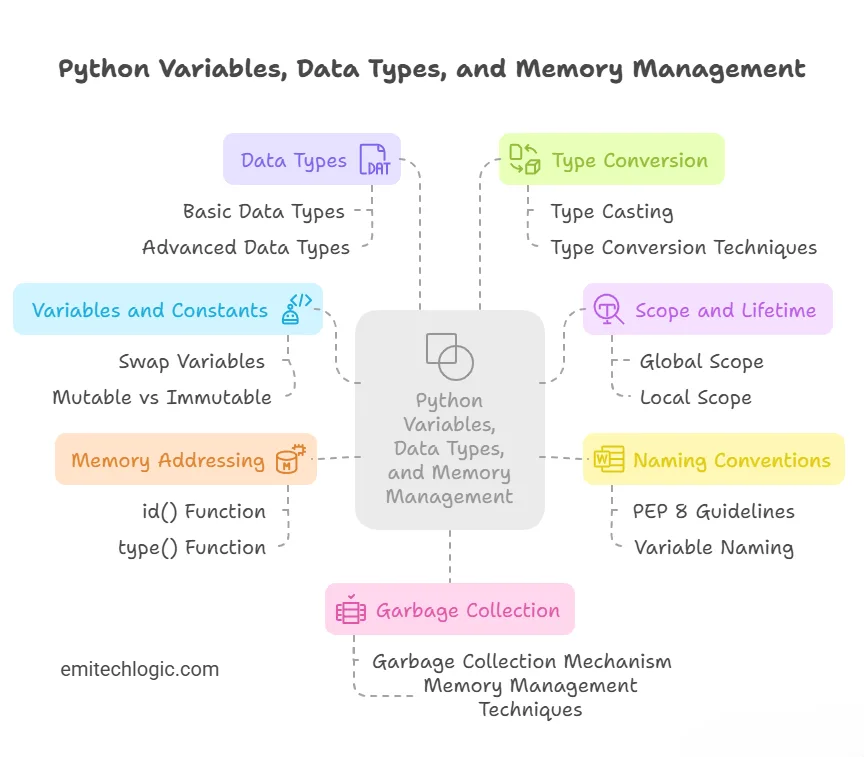
In this section, we’ll explore how Python stores and manages data. We’ll start with variables and constants, how to name them properly, and some best practices. Then, we’ll look at how Python handles memory—how variables store values, how to check memory addresses with id(), and how to identify data types with type().
We’ll also cover basic data types like numbers and text, as well as advanced ones like lists and dictionaries. You’ll learn about mutable vs immutable types, how to convert between data types, and how Python automatically cleans up memory using garbage collection. By the end, you’ll have a solid understanding of how Python manages data efficiently!
- Variables and Constants in Python
- Scope and Lifetime of Variables in Python
- Naming Conventions and Best Practices
- Swap Two Variables Without a Temp Variable
id()Function: Understanding Memory Addressingtype()Function: Checking Data Types- Mutable vs Immutable Types
- Basic Data Types: Integers, Floats, Strings, Booleans
- Advanced Data Types: Lists, Tuples, Sets, Dictionaries (Part 1)
- Advanced Data Types: Lists, Tuples, Sets, Dictionaries (Part 2)
- Type Conversion
- Type Casting
- Understanding Garbage Collection in Python
03 – Input and Output Handling

In this section, we’ll learn how to display output and take input in Python. We’ll start with the print() function, exploring how to format output neatly. Then, we’ll use the input() function to take user input and even handle multiple inputs at once.
We’ll also dive into file handling, where you’ll learn how to read from and write to files—an essential skill for working with data. By the end, you’ll be able to interact with users and manage files effortlessly in Python!
print()Function: Formatting Outputinput()Function: Taking User Input- Handling Multiple Inputs
- File Handling Basics: Reading and Writing Files
04 – Operators in Python

In this section, we’ll explore operators—the building blocks of calculations and logic in Python. We’ll start with arithmetic operators for basic math, then move on to logical operators that help us make decisions in code. We’ll also cover identity (is, is not) and membership (in, not in) operators, which help compare objects and check if a value exists in a collection.
Beyond the basics, we’ll dive into bitwise operators, which manipulate binary data. These are super useful in fields like cryptography and networking. Finally, we’ll explore math concepts in Python, including arithmetic and geometric progressions, summing natural numbers, and even finding the last digit of a number efficiently. By the end, you’ll have a solid grip on how Python handles calculations and logic!
- Arithmetic Operators
- Logical Operators
- Identity Operators (
is,is not) - Membership Operators (
in,not in) - Bitwise Operators (Beyond Basics!)
- Bitwise AND, OR, XOR
- Left and Right Shift Operations
- Applications in Cryptography and Networking
- Mathematical Concepts in Python
- Arithmetic Progression (AP) nth Term
- Geometric Progression (GP) nth Term
- Sum of Natural Numbers
- Finding the Last Digit of a Number
05 – Conditional Statements (Flow Control)

In this section, we’ll learn how to control the flow of a program using conditional statements. Python’s if, else, and elif statements allow us to make decisions based on conditions—just like we do in real life.
We’ll put these concepts into action with practical examples like checking if a number is even or odd, finding the largest of three numbers, and determining whether a year is a leap year. To wrap things up, we’ll build a simple calculator program that responds to user input. By the end, you’ll be able to write Python programs that think and make decisions on their own!
if,else,elifStatements- Practical Examples:
- Check Even or Odd
- Find the Largest of Three Numbers
- Leap Year Checker
- Calculator Program
06 – Loops and Iteration Techniques
In this section, we’ll explore loops, which allow us to repeat tasks without writing the same code over and over. We’ll start with the while loop and for loop, learning when to use each. You’ll also see how the range() function helps control loops, and how break and continue give you more flexibility.
We’ll put loops to work by creating pattern-based programs, like squares, triangles, and pyramids. Then, we’ll move to math-based problems, such as counting digits, calculating factorials, finding the GCD and LCM, generating the Fibonacci series, and checking for prime numbers. To wrap it up, we’ll explore optimization techniques to make your programs run faster. By the end, you’ll be able to handle repetition efficiently in Python!

whileLoopforLooprange()Function: Advanced UsesbreakstatementscontinueStatements- Nested Loops and Their Use Cases
- Pattern Printing in Python
- Square Pattern
- Triangle and Pyramid Patterns
- Inverted Triangle
- Mathematical Implementations:
- Count Digits in a Number
- Compute Factorial
- Find GCD (Greatest Common Divisor)
- Compute LCM (Least Common Multiple)
- Generate Fibonacci Series
- Prime Number Checker
- Find All Divisors of a Number
- Optimizing Prime Number and Divisor Algorithms
07 – Functions and Modular Programming
In this section, we’ll explore functions, which help us break down complex tasks into reusable pieces. You’ll learn how to create your own functions and use different types of arguments—default values, keyword arguments, and flexible inputs with *args and **kwargs.
We’ll also discuss how Python handles parameter passing and how to return multiple values from a function. You’ll see the difference between global and local variables and when to use them.
To put these concepts into action, we’ll solve real-world math problems, like finding the first digit of a number and performing prime factorization. By the end, you’ll be able to write cleaner, more efficient Python programs using modular programming!

- Creating and Using Functions
- Function Arguments:
- Default Arguments
- Keyword Arguments
- Variable-Length Arguments (
*args,**kwargs)
- Parameter Passing Techniques
- Returning Multiple Values from a Function
- Global vs Local Variables
- Mathematical Applications:
- Finding First Digit of a Number
- Prime Factorization Algorithm
08 – String Handling and Operations
In this section, we’ll dive into strings, one of the most powerful data types in Python. You’ll learn how to work with text efficiently, from basic slicing and indexing to advanced string operations.
We’ll cover formatted strings, including f-strings and .format(), which make output cleaner. You’ll also explore string methods to manipulate text, compare strings, and search for patterns using regular expressions (regex).
To make things practical, we’ll solve problems like checking for palindromes, reversing strings efficiently, and even converting numbers between decimal and binary. By the end, you’ll have a solid grasp of handling text in Python!
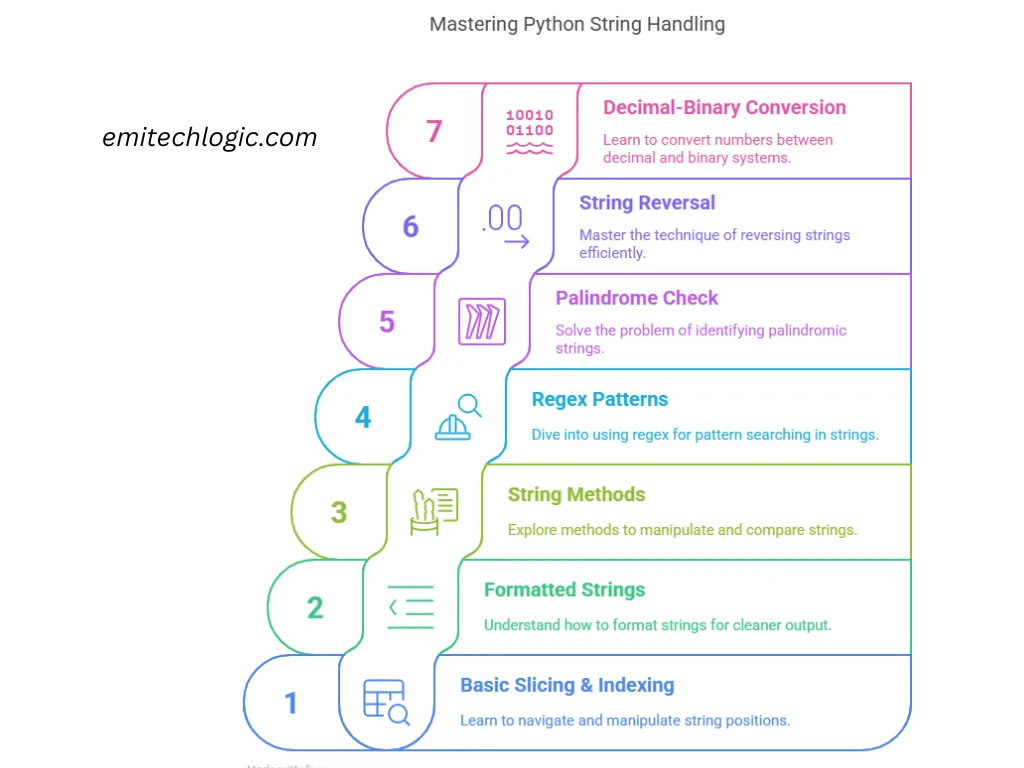
- Escape Sequences and Raw Strings
- Formatted Strings (
f-strings,.format()) - String Slicing and Indexing
- Methods and Operations
- String Comparisons
- Searching for Patterns in Strings (Regex)
- Checking for Palindrome Strings
- Reversing a String Efficiently
- Converting Decimal to Binary and Binary to Decimal
09 – Lists, Tuples, and Advanced Data Structures

In this section, we’ll explore lists, tuples, sets, and dictionaries, the core data structures in Python. You’ll learn how to store, access, and manipulate data efficiently using these structures.
We’ll cover list operations, slicing, and when to use tuples instead of lists. You’ll also discover the power of sets for handling unique values and dictionaries for key-value storage.
For advanced techniques, we’ll dive into list comprehensions, different sorting methods, and practical tasks like checking if a list is sorted or finding unique elements. By the end, you’ll be able to handle data like a pro!
- List Operations and Slicing
- Tuples: When to Use Them?
- Sets and Their Applications
- Dictionary Operations and Methods
- Advanced List Operations:
- List Comprehensions
- Sorting Techniques in Lists
- Checking If a List is Sorted
- Finding Unique Elements in a List
10 – Object-Oriented Programming (OOP) in Python
Now, let’s step into Object-Oriented Programming (OOP)—one of the most powerful features of Python. Instead of just writing code that runs step by step, OOP lets us organize and structure programs using real-world concepts like objects and classes.
We’ll start with the basics of OOP, understanding how classes and objects work. Then, we’ll explore encapsulation to protect data, inheritance to reuse code, and polymorphism to make functions more flexible.
You’ll also learn method overriding, operator overloading, and abstract classes, which allow for even more advanced customization. By the end, you’ll be able to write cleaner, reusable, and more scalable Python code!

- Introduction to OOP
- Classes and Objects
- Encapsulation and Data Abstaction
- Class and Instance Attributes
- Access Modifiers in Python (
public,private,protected) - Static and Class Methods
- Inheritance (Single, Multiple, Multilevel)
- Method Overriding and Polymorphism
- Abstract Classes and Interfaces
- Operator Overloading
11 – File Handling and Exception Management
Working with files and handling errors is a must for any real-world Python program. In this section, we’ll learn how to read and write files, including working with CSV and JSON formats, which are widely used for storing and sharing data.
But what if something goes wrong? That’s where exception handling comes in. We’ll see how to use try, except, and finally to catch and handle errors gracefully instead of letting them crash our program.
We’ll also cover raising custom exceptions to make debugging easier and explore logging in Python to keep track of important events in your program. By the end, you’ll know how to manage files and handle errors.

- Reading and Writing Files
- Handling CSV and JSON Files
- Exception Handling (
try,except,finally) - Raising Custom Exceptions
- Exception and Error Handling in Python
- Logging in Python
12 – Advanced Python Topics
Now that we’ve covered the basics, it’s time to level up with some advanced Python concepts that make coding more efficient and powerful.
We’ll start with lambda functions, which let you write quick, one-line functions without the usual def keyword. Then, we’ll explore list, set, and dictionary comprehensions, which help you create complex data structures in a clean and readable way.
You’ll also learn about map, filter, and reduce, powerful tools for processing data efficiently. We’ll dive into generators and iterators, which help you handle large amounts of data without using too much memory.
Then comes decorators, an elegant way to modify functions without changing their code. Finally, we’ll touch on multithreading, multiprocessing, and asynchronous programming—essential for writing fast, responsive programs that can handle multiple tasks at once.

By the end of this section, you’ll have a solid grasp of these advanced techniques and be ready to tackle more complex Python projects!
- Lambda Functions
- List, Set, and Dictionary Comprehensions
- Map, Filter, and Reduce Functions
- Generators and Iterators
- Python Decorators
- Multithreading vs Multiprocessing
- Asynchronous Programming in Python (
async,await)
13 – Working with External Libraries
Python has a rich ecosystem of external libraries that make coding easier, especially when working with data, numbers, and visualizations.
We’ll start with NumPy, which is great for handling large numerical datasets efficiently. Then, we’ll explore Pandas, a must-have for working with structured data like tables and spreadsheets.
For visualizing data, we’ll use Matplotlib and Seaborn, which help turn raw numbers into clear and insightful charts. Finally, we’ll look at SciPy, which builds on NumPy and provides powerful tools for scientific computing.
By the end of this section, you’ll be able to analyze, process, and visualize data like a pro!

- NumPy for Numerical Computing
- Pandas for Data Analysis
- Matplotlib and Seaborn for Data Visualization
- SciPy for Scientific Computing
14 – Web Development with Python

Python isn’t just for scripts and data—it’s also great for building web applications!
In this section, we’ll explore Flask and Django, two of the most popular frameworks for web development. Flask is lightweight and flexible, perfect for quick projects, while Django is powerful and full-featured, great for larger applications.
We’ll also build a simple web app with Flask to see how everything comes together. Then, we’ll dive into REST APIs, which allow different applications to communicate with each other.
By the end, you’ll know how to create dynamic web applications and APIs using Python!
- Introduction to Flask and Django
- Building a Simple Web App with Flask
- REST APIs in Python
15 – Databases and SQL in Python
Python makes it easy to work with databases, whether you’re dealing with SQL or NoSQL.
We’ll start with SQLite, a lightweight database that’s built into Python—perfect for small projects. Then, we’ll move to MySQL, where you’ll learn to perform CRUD operations (Create, Read, Update, Delete) using Python. Finally, we’ll explore MongoDB, a NoSQL database that’s great for handling large-scale, unstructured data.
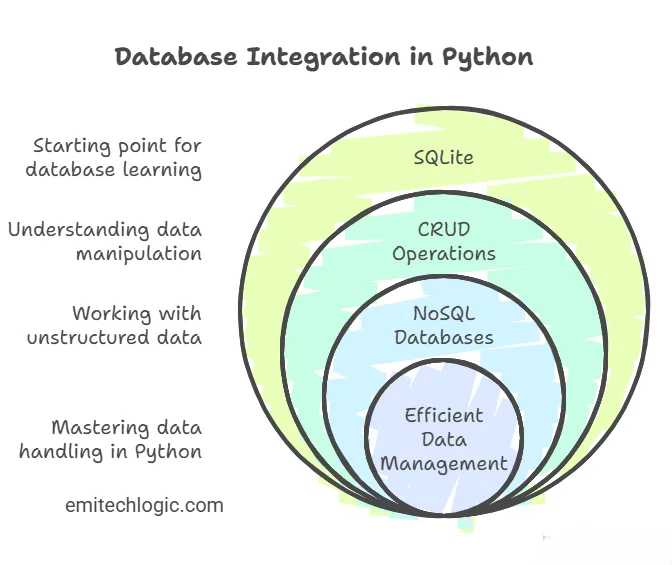
By the end of this section, you’ll be able to store, retrieve, and manage data efficiently in your Python applications!
- Using SQLite with Python
- CRUD Operations in MySQL with Python
- Working with NoSQL Databases (MongoDB)
16 – Machine Learning and AI with Python
Python is one of the most powerful languages for Machine Learning and AI!
We’ll start by understanding what Machine Learning is and how Python makes it easy to build models. Then, we’ll dive into Scikit-Learn, a popular library for training ML models. For more advanced topics, we’ll explore Deep Learning with TensorFlow and PyTorch, two of the most widely used frameworks. Finally, we’ll touch on Natural Language Processing (NLP)—the technology behind chatbots, sentiment analysis, and text generation.
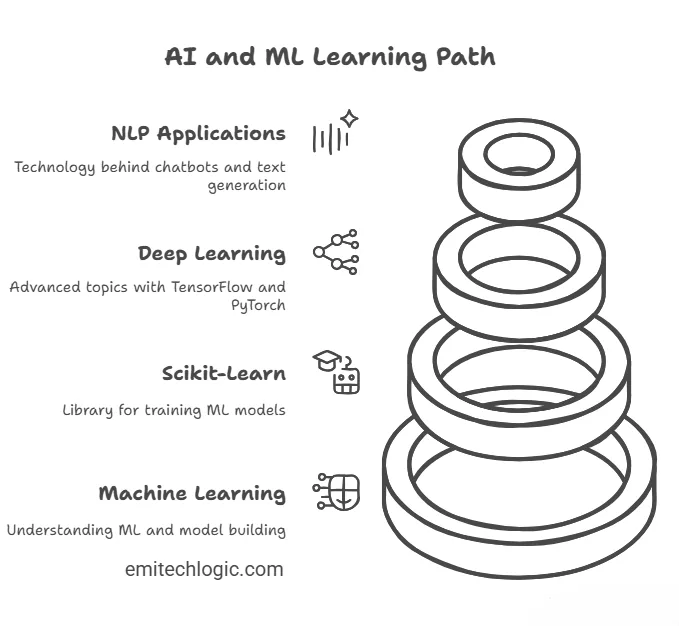
By the end of this section, you’ll have a solid foundation to build and experiment with AI models in Python!
- Introduction to Machine Learning
- Using Scikit-Learn for ML Models
- Deep Learning with TensorFlow and PyTorch
- Natural Language Processing (NLP) with Python
17 – Automating Tasks with Python

Python isn’t just for data science and web development—it’s also great for automating repetitive tasks! In this section, we’ll explore how to scrape data from websites using BeautifulSoup and Scrapy, automate emails and reports, and even work with Excel files programmatically using OpenPyXL.
By the end, you’ll be able to save hours of manual work by letting Python handle tedious tasks for you!
- Web Scraping with BeautifulSoup and Scrapy
- Automating Emails and Reports
- Automating Excel with OpenPyXL
18 – Advanced Problem Solving and Algorithms
Solving complex problems efficiently is what separates a good programmer from a great one. In this section, we’ll explore powerful sorting algorithms like QuickSort, MergeSort, and HeapSort, along with searching techniques like Binary Search, BFS, and DFS. We’ll also introduce Dynamic Programming, a must-know concept for tackling optimization problems. By the end, you’ll be able to write smarter, faster code to handle real-world challenges!

- Sorting Algorithms: QuickSort, MergeSort, HeapSort
- Searching Algorithms: Binary Search, BFS, DFS
- Dynamic Programming Basics
19 – Python for Cybersecurity and Ethical Hacking
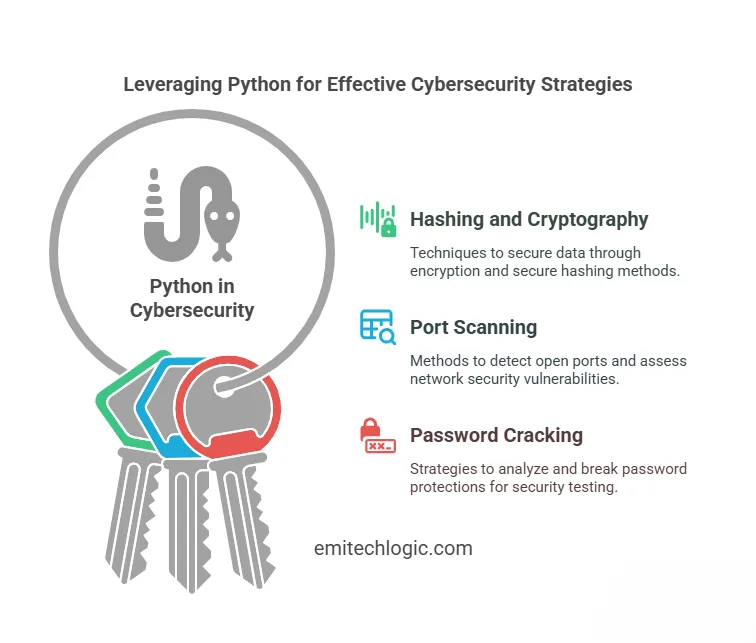
Cybersecurity is all about protecting data and systems from attacks, and Python plays a huge role in this field. In this section, we’ll explore hashing and cryptography to secure information, build a simple port scanner to detect open network ports, and understand password cracking techniques used by both attackers and security professionals. By the end, you’ll have a solid foundation in using Python for ethical hacking and cybersecurity tasks.
- Hashing and Cryptography Basics
- Writing a Simple Port Scanner
- Password Cracking Techniques
20 – Python for Cloud and DevOps

Cloud computing and DevOps make software deployment faster and more efficient, and Python is a key tool in this space. In this section, we’ll explore AWS Lambda for running serverless applications and use Boto3 to interact with AWS services. We’ll also dive into CI/CD (Continuous Integration and Deployment) with Jenkins and Python, automating workflows to streamline development and deployment processes.
- Working with AWS Lambda and Boto3
- CI/CD with Python and Jenkins
Conclusion
By the time you finish this course, you’ll have a solid foundation in Python—from basic programming concepts to advanced topics like machine learning, web development, automation, and cybersecurity. We’ve covered essential problem-solving techniques, data handling, and real-world applications that will help you tackle any Python-related project with confidence.
Python is more than just a programming language—it’s a tool that can automate tasks, analyze data, build applications, and even power AI models. Keep practicing, explore new challenges, and most importantly, keep coding. The more you experiment, the more you’ll grow as a Python developer.
